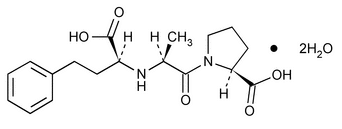Enalaprilat
(en al' a pril at'').
l-Proline, 1-[N-(1-carboxy-3-phenylpropyl)-l-alanyl]-, dihydrate, (S)-.
1-[N-[(S)-1-Carboxy-3-phenylpropyl]-l-alanyl]-l-proline dihydrate
» Enalaprilat contains not less than 98.0 percent and not more than 101.0 percent of C18H24N2O5, calculated on the anhydrous basis.
Packaging and storage—
Preserve in well-closed containers.
Identification—
A:
Infrared Absorption  197M
197M —[note—If the spectrum is not comparable to that of the Reference Standard, expose the specimen and Reference Standard to an environment of 98% relative humidity (use a chamber conditioned with a saturated solution of calcium sulfate) for 1 to 3 days to equilibrate them. Prepare dispersions from the equilibrated specimen and Reference Standard, and record the spectra. ]
—[note—If the spectrum is not comparable to that of the Reference Standard, expose the specimen and Reference Standard to an environment of 98% relative humidity (use a chamber conditioned with a saturated solution of calcium sulfate) for 1 to 3 days to equilibrate them. Prepare dispersions from the equilibrated specimen and Reference Standard, and record the spectra. ]
B:
The retention time of the major peak in the chromatogram of the Assay preparation corresponds to that of the Standard preparation as obtained in the Assay.
Water, Method I  921
921 :
between 7.0% and 11.0%.
:
between 7.0% and 11.0%.
Residue on ignition  281
281 :
not more than 0.2%.
:
not more than 0.2%.
Heavy metals, Method II  231
231 :
0.002%.
:
0.002%.
Assay—
pH 3 buffer—
Dissolve 1.36 g of monobasic potassium phosphate in 950 mL of water, adjust with phosphoric acid to a pH of 3.0 ± 0.1, dilute with water to 1000 mL, and mix.
Solvent mixture—
Prepare a mixture of acetonitrile, methanol, and pH 3 buffer (2:2:1). Adjust with phosphoric acid to a pH of 3.0 ± 0.1, and mix.
Diluent—
Prepare a mixture of pH 3 buffer and Solvent mixture (92:8), and filter.
Mobile phase—
Prepare a filtered and degassed mixture of pH 3 buffer and Solvent mixture (85:15). Make adjustments if necessary (see System Suitability under Chromatography  621
621 ).
).
Standard preparation—
Dissolve an accurately weighed quantity of USP Enalaprilat RS in Diluent to obtain a solution having a known concentration of about 0.3 mg per mL. [note—Use this solution within 24 hours. ]
Assay preparation—
Transfer about 30 mg of Enalaprilat, accurately weighed, to a 100-mL volumetric flask, dissolve in Diluent, dilute with Diluent to volume, and mix.
Chromatographic system
(see Chromatography  621
621 )—The liquid chromatograph is equipped with a 210-nm detector and a 4.6-mm × 15-cm column that contains 4-µm packing L1 and is maintained at 70
)—The liquid chromatograph is equipped with a 210-nm detector and a 4.6-mm × 15-cm column that contains 4-µm packing L1 and is maintained at 70 . The flow rate is about 1.5 mL per minute. Chromatograph the Standard preparation, and record the peak responses as directed for Procedure: the column efficiency determined from the analyte peak is not less than 500 theoretical plates; the tailing factor for the analyte peak is not more than 1.7; and the relative standard deviation for replicate injections is not more than 1.0%.
. The flow rate is about 1.5 mL per minute. Chromatograph the Standard preparation, and record the peak responses as directed for Procedure: the column efficiency determined from the analyte peak is not less than 500 theoretical plates; the tailing factor for the analyte peak is not more than 1.7; and the relative standard deviation for replicate injections is not more than 1.0%.
Procedure—
Separately inject equal volumes (about 20 µL) of the Standard preparation and the Assay preparation into the chromatograph, record the chromatograms, and measure the responses for the major peaks. Calculate the quantity, in mg, of C18H24N2O5 in the portion of Enalaprilat taken by the formula:
100C(rU / rS)
in which C is the concentration, in mg per mL, of USP Enalaprilat RS in the Standard preparation; and rU and rS are the enalaprilat peak responses obtained from the Assay preparation and the Standard preparation, respectively.
Auxiliary Information—
Please check for your question in the FAQs before contacting USP.
| Topic/Question | Contact | Expert Committee |
|---|---|---|
| Monograph | Sujatha Ramakrishna, Ph.D.
Senior Scientific Liaison 1-301-816-8349 |
(SM22010) Monographs - Small Molecules 2 |
| Reference Standards | RS Technical Services 1-301-816-8129 rstech@usp.org |
USP35–NF30 Page 3036

